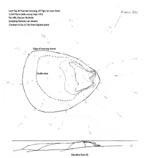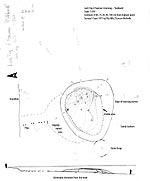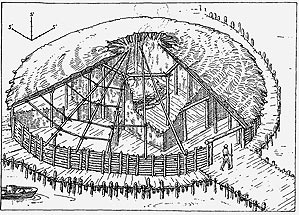Before we began.
Build-up to the Loch Awe survey
Crannog revival
The story is best summarised by the late Ian Morrison in his book Landscape with lake dwellings. The crannogs of Scotland (1985, Edinburgh University Press). Ian, an Edinburgh University geography lecturer and amateur diver, had come across crannogs in his PhD thesis which crossed into archaeological territory. And as a keen Scottish historian and antiquarian he joined forces with two post-graduate archaeologists, K and Duncan McArdle, both amateur divers.
 Field surveys, using a plane table, tapes, diver with ranging pole and marker floats. |
 |
Crannogs just down our road
In 1970-1971, back from two years in South Africa, we were living for a time with K's parents, who owned a farm at the foot of Glen Lyon, Perthshire, about a mile and a half from the village of Fearnan on the north side of Loch Tay. Culdaremore farm made a useful base from which to explore a visible heap of stones in the loch, seen when the water was low, out from the Tigh-an-Loan hotel at Fearnan. We found a very obviously man-made crannog, and in the process came across another, about 150 metres to the east. Still in touch with friends and colleagues in Edinburgh, Pip Hills, Bill Morris and Ian Morrison joined us on dives on these crannogs in the summer of 1971. Between us (with Pip's help from the beginning) we surveyed them both. These are the plans from that time, without the outlying timber shown (click to enlarge).
They gave us an idea of what almost 'ideal' crannogs look like. The loch bottom off Fearnan is relatively flat, sandy, and from this base the steep stone facings of the crannogs loom in the dark water, very convincingly artificial. At the base of both were timbers, some flat on the bed, others sticking up at angles. Off one crannog was a line of eroded piles leading to the shore – looked very like the bases of uprights of a wooden bridge to the crannog.
This led us to search further around the north side of the loch, and following Blundell's suggestions, had a look at the crannog off Kenmore (landscaped in the 19th century), Priory Island, and an unmentioned crannog off the Forestry Slipway between Fearnan and Kenmore.
K took up crannogs as the topic for her PhD research under Professor Stuart Piggott at Edinburgh in 1971, after these surveys in Loch Tay.
Spreading the word: brick wall
The archaeological network in Scotland, indeed the whole UK, in the late 1960s/early 1970s was very small, compared with today. Ian and we (back in Edinburgh by 1971) spread the word about the east Loch Tay crannogs as real live monuments, and were surprised to meet a wall of scepticism, particularly from the Royal Commisssion on Ancient and Historical Monuments for Scotland (RCAHMS), maybe for the reasons we suggest elsewhere. We had to do a lot more to convince our Establishment; and to be honest, maybe ourselves too. Field-surveying a couple of crannogs that nobody could see in Loch Tay was exciting, but not going to dent the prevailing doubt. We had to come up with more monuments in more lochs, done systematically.
So over the next few months we drummed up as many friends and colleagues as possible to visit likely lochs within reach of Edinburgh, containing what seemed, from the maps and aerial photos, possible islands. Some of these were natural, some crannogs. Not all could be surveyed, some we just examined and assessed.
Failures and successes
 • Milton Loch I, the 5th-century BC crannog excavated by Peggy Piggott (later Guido) in 1953 (this is her reconstruction). She dated it 2nd century AD from surface finds but the McArdles felt this date was unlikely – too late – due to the wooden ard find below the floor. In 1972 McArdle and Hills extracted a pile from the crannog; this, forwarded to Guido, and the ard gave the C14 date above: early Iron Age. More recently, another radiocarbon date comes more in line with Guido's first estimate, suggesting a very long, or two periods of occupation at Milton Loch I. We also had a look at the other crannog in the loch; not the sort of construction we had seen in Loch Tay but would meet again in Loch Awe |
• Linlithgow Loch seemed to have a very likely island in it, close by the Palace. We spent an amazingly frustrating day in a borrowed rowing boat of extruded foam (so it was very light) trying to row (no engine) against a squally wind to get to a round island in the south end of the loch. Finally there, already tired, we tried for some time to climb up onto the island, sliding back each time into the water down a surface of cormorant guano. When on top, there was no evidence of any sort of building with stones or timber that you could see: just more bird dung, humus and very thick vegetation and trees. Back into the water to try to find an edge of, say, stones, was like being in a plate of potato soup: visibility was the inside of your mask. After half an hour of groping around the island in mud we all retired, defeated. What it told us was that lochs and islands (this one typical of Lowland lochs) like this were going to take special tactics, certainly not for a day visit, if we were going to get convincing results.
• Loch Vennachar in Perthshire, by contrast, was another Highland loch. It had been part of the Water Board supply system for Glasgow for many years, the water level raised in the 19th century. We (Ian, K, Duncan) made a visit on 23 January 1972 to the east-end island, a suggested crannog. It was quite a swim to the submerged island in near-freezing windy conditions (snow flakes whipping past) and in wet suits, getting cold, a necessarily brief visit revealed a crannog of similar size to the Fearnan ones in Loch Tay. Stone-built, it sits on the edge of a steep underwater slope. We saw no timber in the surface (but it was hard to concentrate with your teeth chattering underwater) only about 20 complete trees (roots, branches and all) lying on the slope down from the crannog. Near-hypothermia was again a warning that better organisation was needed for convincing results.
There were more loch visits, some inconclusive; part of the learning process of how not to do it. So the chance to get a trained group of divers looking for a project arrived at an ideal time. We needed a full professional survey to convince the sceptics. The crannog survey of Loch Awe, where we could combine the archaeological work with some marine research, was on.
Back to front page